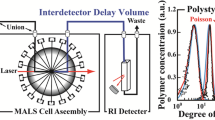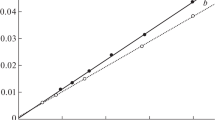Summary
The advantages of evaporative light-scattering detection over UV detection for the quantitation of combinatorial libraries composed of small organic compounds by HPLC are described. The detector's response is independent of the sample chromophore, which makes it well-suited to chromatographie analyses of mixtures of dissimilar solutes. Thus, HPLC with evaporative light-scattering detection offers the potential for reducing false positive or false negative results in screening assays, because of its ability to detect the presence of impurities that absorb poorly in the UV (e.g., those impurities originating from the polymeric support). Furthermore, the evaporative light-scattering detector exhibits a nearly equivalent response to compounds of similar structural class. Hence, rapid quantitation of compound libraries may be carried out with the use of a single external standard. For example, the quantitation errors, based on a single external standard, for a series of steroids, hydantoins, and BOC- and Fmoc-protected amino acids by normal-phase HPLC with evaporative light-scattering detection average approximately ± 10%. The application of the evaporative light-scattering detector to the quantitation of low-level sample impurities and the detector's compatibility with gradient elution are also described.
Similar content being viewed by others
References
DeWitt, S.H.,Molecular diversity strategies, Pharm. News, 1 (1994) 11–14.
Gallop, M.A., Barrett, R.W., Dower, W.J., Fodor, S.P.A. and Gordon, E.M.,Applications of combinatorial technologies to drug discovery. 1. Background and peptide combinatorial libraries, J. Med. Chem., 37 (1994) 1233–1251.
Gallop, M.A., Barrett, R.W., Dower, W.J., Fodor, S.P.A. and Gordon, E.M.,Applications of combinatorial technologies to drug discovery. 2. Combinatorial organic synthesis, library screening strategies, and future directions, J. Med. Chem., 37 (1994) 1385–1401.
Patek, M., Drake, B. and Lebl, M.,Solid-phase synthesis of ‘small’ organic molecules based on a thiazolidine scaffold, Tetrahedron Lett, 36 (1995) 2227–2230.
Ostresh, J.M., Husar, G.M., Blondelle, S.E., Dorner, B., Weber, P.A. and Houghten, R.A.,‘Libraries from libraries’: Chemical transformation of combinatorial libraries to extend the range and repertoire of chemical diversity, Proc. Natl. Acad. Sci. USA, 91 (1994) 11138–11142.
Hutchins, S.M. and Chapman, K.T.,A strategy for urea-linked diamine libraries, Tetrahedron Lett., 36 (1995) 2583–2586.
Bray, A.M., Chiefari, D.S., Valerio, R.M. and Maeji, N.J.,Rapid optimization of organic reactions on solid phase using the multipin approach: Synthesis of 4-aminoproline analogues by reductive amination, Tetrahedron Lett., 36 (1995) 5081–5084.
DeWitt, S.H., Schroeder, M.C., Stankovic, C.J., Strode, J.E. and Czarnik, A.W.,DIVERSOMER TM technology: Solid-phase synthesis, automation, and integration for the generation of chemical diversity, Drug Dev. Res., 33 (1994) 116–124.
DeWitt, S.H., Kiely, J.S., Stankovic, C.J., Schroeder, M.C., Reynolds-Cody, D.M. and Pavia, M.R.,‘Diversomers’: An approach to nonpeptide, nonoligomeric chemical diversity, Proc. Natl. Acad. Sci. USA, 90 (1993) 6909–6913.
Eberhart-Thomson, S., Hatzis, A. and Rothchild, R.,Quantitative NMR assay for aspirin, phenacetin, and caffeine mixtures with 1,3,5-trioxane as internal standard, J. Pharm. Biomed. Anal., 4 (1986) 147–154.
Ford, D.L. and Kennard, W.,Vaporization analyzer, J. Oil Colour Chem. Assoc., 49 (1966) 299–313.
Bear, G.R.,Universal detection and quantitation of surfactants by high-performance liquid chromatography by means of the evaporative light-scattering detector, J. Chromatogr., 459 (1988) 91–107.
Stolyhwo, A., Colin, H. and Guiochon, G.,Analysis of triglycerides in oils and fats by liquid chromatography with the laser lightscattering detector, Anal. Chem., 57 (1985) 1342–1354.
Sotirhos, N., Thorngren, C. and Herslof, B.,Reversed-phase high-performance liquid Chromatographic separation and mass detection of individual phospholipid classes, J. Chromatogr., 331 (1985) 313–320.
Macrae, R. and Dick, J.,Analysis of carbohydrates using the mass detector, J. Chromatogr., 210 (1981) 138–145.
Peterson, J.A. and Risley, D.S.,Validation of an HPLC method for the determination of sodium in LY293111 sodium, a novel LTB 4 receptor antagonist, using evaporative light-scattering detection, J. Liq. Chromatogr., 18 (1995) 331–338.
Lafosse, M., Elfakir, C., Morin-Allory, L. and Dreux, M.,The advantages of evaporative light-scattering detection in pharmaceutical analysis by high-performance liquid chromatography and supercritical fluid chromatography, J. High-Res. Chromatogr., 15 (1992) 312–318.
Stockwell, P.B. and King, B.W.,A light-scattering detector for liquid chromatography, Am. Lab., 23 (1991) 19–24.
Mourey, T.H. and Oppenheimer, L.E.,Principles oj operation of an evaporative light-scattering detector for liquid chromatography, Anal. Chem., 56 (1984) 2427–2434.
Charlesworth, J.M.,Evaporative analyzer as a mass detector for liquid chromatography, Anal. Chem., 50 (1978) 1414–1420.
Van den Bossche, G.,Etude goniometrique et optique de quelques corticosteroides C 21 1.Corticosteroides cristallisant dans le système orthorhombique, Bull. Soc. R. Sci. Liège, 40 (1971) 142–151.
Van den Bossche, G.,Etude goniometrique et optique de quelques corticosteroides C 21 2.Corticosteroides cristallisant dans le système monoclinique, Bull. Soc. R. Sci. Liège, 40 (1971) 152–161.
Asmus, P.A. and Landis, J.B.,Analysis of steroids in bulk pharmaceuticals by liquid chromatography with light-scattering detection, J. Chromatogr., 316 (1984) 461–472.
Stolyhwo, A., Colin, H. and Guiochon, G.,Use of light-scattering as a detector principle in liquid chromatography, J. Chromatogr., 265 (1983) 1–18.
Stolyhwo, A., Colin, H., Martin, M. and Guiochon, G.,Study of the qualitative and quantitative properties of the light-scattering detector, J. Chromatogr., 288 (1984) 253–275.
Author information
Authors and Affiliations
Rights and permissions
About this article
Cite this article
Kibbey, C.E. Quantitation of combinatorial libraries of small organic molecules by normal-phase HPLC with evaporative light-scattering detection. Mol Divers 1, 247–258 (1996). https://doi.org/10.1007/BF01715529
Received:
Accepted:
Issue Date:
DOI: https://doi.org/10.1007/BF01715529




